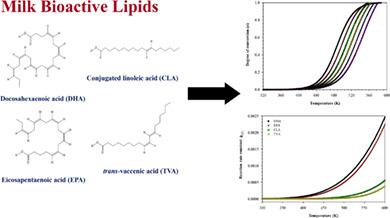当前位置:
X-MOL 学术
›
J. Food Process Eng.
›
论文详情
Our official English website, www.x-mol.net, welcomes your
feedback! (Note: you will need to create a separate account there.)
Kinetic analysis of non‐isothermal oxidation of bioactive milk lipids
Journal of Food Process Engineering ( IF 2.7 ) Pub Date : 2020-09-15 , DOI: 10.1111/jfpe.13519 Shouyun Cheng 1 , Lin Wei 2 , Kasiviswanathan Muthukumarappan 2 , Sergio I. Martínez‐Monteagudo 1, 3, 4
Journal of Food Process Engineering ( IF 2.7 ) Pub Date : 2020-09-15 , DOI: 10.1111/jfpe.13519 Shouyun Cheng 1 , Lin Wei 2 , Kasiviswanathan Muthukumarappan 2 , Sergio I. Martínez‐Monteagudo 1, 3, 4
Affiliation

|
The oxidation of pure docosahexaenoic acid (DHA, C22:6 ω3), eicosapentaenoic acid (EPA, C20:5 ω3), conjugated linoleic acid (CLA, C18:2), and trans‐vaccenic acid (TVA, C18:1 t11) was assessed using differential scanning calorimetry (DSC) at six heating rates (3–18 K min−1) within a range of 300–600 K. The DSC spectra were analyzed using iso‐conversional kinetics to calculate the pre‐exponential factor (Ao), activation energy (Eo), and reaction model (f(α)). The Eo for DHA, EPA, CLA, and TVA varied from 33–40, 36–49, 48–64, and 64–92 kJ/mol, respectively. The Ao were 2.87 ± 0.03, 4.42 ± 0.21, 24.94 ± 1.31, and 580.91 ± 4.61 min−1 for DHA, EPA, CLA, and TVA, respectively. The comparison of the numerically reconstructed model with theoretical values showed that the oxidation of DHA and EPA was best described by an Avrami‐Erofeev model, while a three‐dimensional diffusion model best described the oxidation of CLA and TVA.
中文翻译:

生物活性乳脂非等温氧化的动力学分析
纯二十二碳六烯酸(DHA,C22:6ω3),二十碳五烯酸(EPA,C20:5ω3),共轭亚油酸(CLA,C18:2)和反式-痘苗酸(TVA,C18:1 t11)的氧化使用差示扫描量热法(DSC)在300–600 K范围内以六种加热速率(3–18 K min -1)进行了评估。使用等转换动力学分析了DSC光谱以计算指数前因子(A o),活化能(E o)和反应模型(f(α))。DHA,EPA,CLA和TVA的E o分别为33-40、36-49、48-64和64-92 kJ / mol。在一个Ø对于DHA,EPA,CLA和TVA,分别为2.87±0.03、4.42±0.21、24.94±1.31和580.91±4.61 min -1。数值重建模型与理论值的比较表明,Avrami-Erofeev模型最能描述DHA和EPA的氧化,而三维扩散模型最能描述CLA和TVA的氧化。
更新日期:2020-11-09
中文翻译:

生物活性乳脂非等温氧化的动力学分析
纯二十二碳六烯酸(DHA,C22:6ω3),二十碳五烯酸(EPA,C20:5ω3),共轭亚油酸(CLA,C18:2)和反式-痘苗酸(TVA,C18:1 t11)的氧化使用差示扫描量热法(DSC)在300–600 K范围内以六种加热速率(3–18 K min -1)进行了评估。使用等转换动力学分析了DSC光谱以计算指数前因子(A o),活化能(E o)和反应模型(f(α))。DHA,EPA,CLA和TVA的E o分别为33-40、36-49、48-64和64-92 kJ / mol。在一个Ø对于DHA,EPA,CLA和TVA,分别为2.87±0.03、4.42±0.21、24.94±1.31和580.91±4.61 min -1。数值重建模型与理论值的比较表明,Avrami-Erofeev模型最能描述DHA和EPA的氧化,而三维扩散模型最能描述CLA和TVA的氧化。











































 京公网安备 11010802027423号
京公网安备 11010802027423号